Digital Engineering Skills and Knowledge Reflection Report: CIVE345
VerifiedAdded on 2022/09/23
|16
|3675
|54
Report
AI Summary
This report is a personal reflection on the digital skills and knowledge acquired in the field of construction management. It details the application of various software tools, including AutoCAD for 2D and 3D designs, Autodesk Revit for Building Information Modeling (BIM), OASYS GSA for structural analysis, and Microsoft Office for document creation and presentations. The report emphasizes the importance of BIM in the construction lifecycle, highlighting its benefits such as improved visualization, collaboration, and elimination of risks. It also discusses the application of BIM in planning, pre-construction, and model development phases. The author demonstrates how these digital skills have contributed to their development as a digital engineer, emphasizing the ability to integrate technical skills, work in multidisciplinary teams, and adapt to the evolving technological landscape of the construction industry. The report covers the Joint Board of Moderators (JBM) qualities of a competent digital engineer.
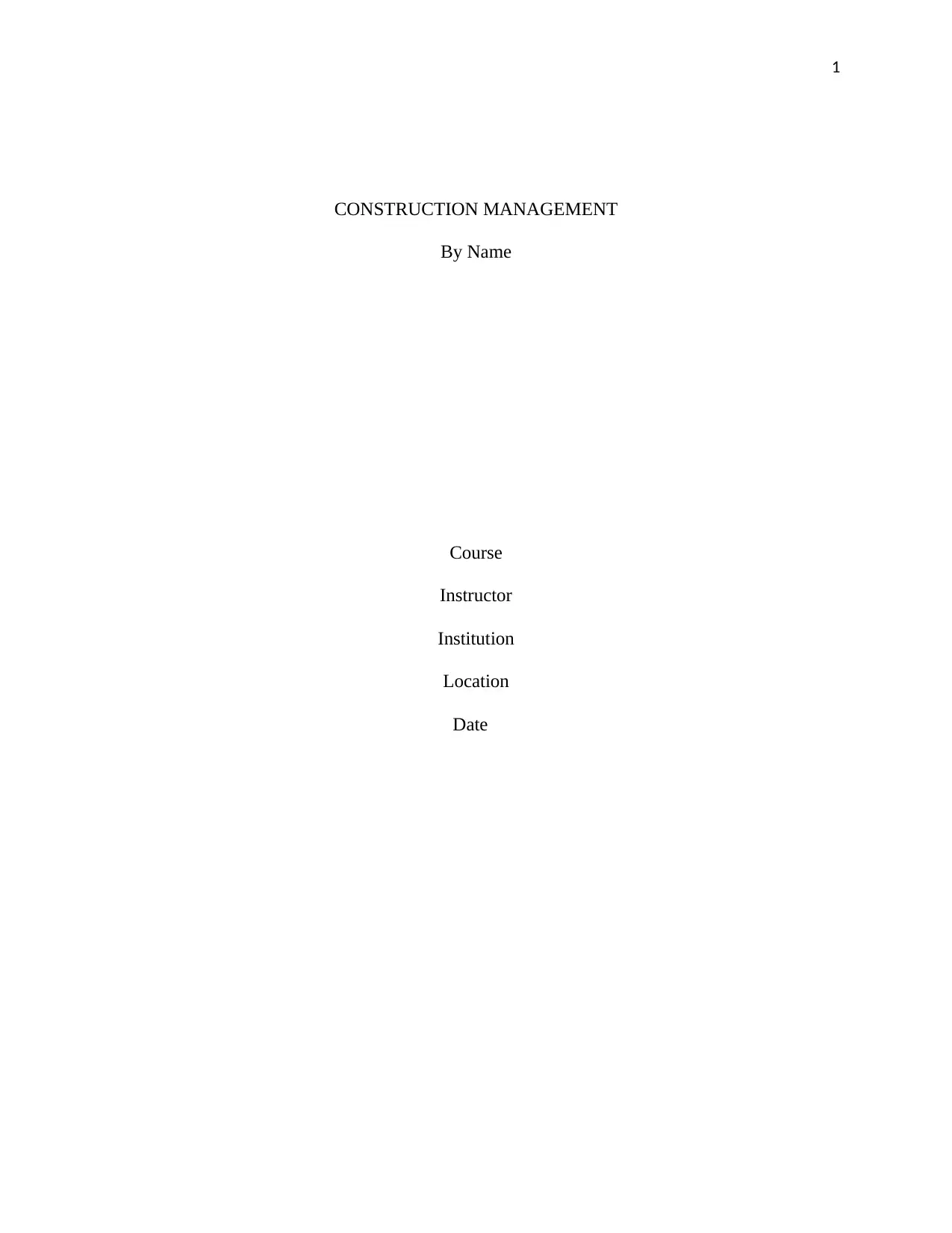
1
CONSTRUCTION MANAGEMENT
By Name
Course
Instructor
Institution
Location
Date
CONSTRUCTION MANAGEMENT
By Name
Course
Instructor
Institution
Location
Date
Paraphrase This Document
Need a fresh take? Get an instant paraphrase of this document with our AI Paraphraser
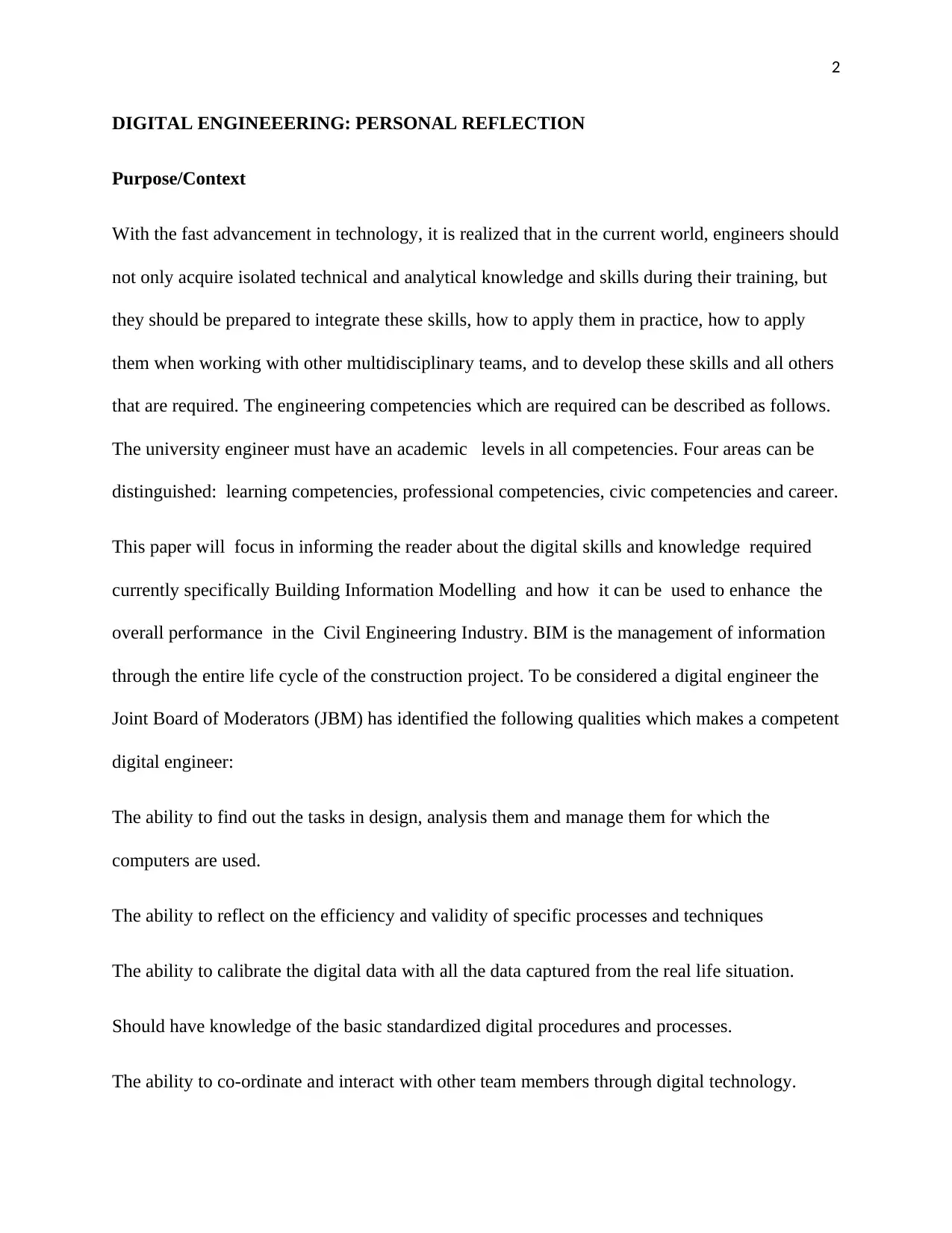
2
DIGITAL ENGINEEERING: PERSONAL REFLECTION
Purpose/Context
With the fast advancement in technology, it is realized that in the current world, engineers should
not only acquire isolated technical and analytical knowledge and skills during their training, but
they should be prepared to integrate these skills, how to apply them in practice, how to apply
them when working with other multidisciplinary teams, and to develop these skills and all others
that are required. The engineering competencies which are required can be described as follows.
The university engineer must have an academic levels in all competencies. Four areas can be
distinguished: learning competencies, professional competencies, civic competencies and career.
This paper will focus in informing the reader about the digital skills and knowledge required
currently specifically Building Information Modelling and how it can be used to enhance the
overall performance in the Civil Engineering Industry. BIM is the management of information
through the entire life cycle of the construction project. To be considered a digital engineer the
Joint Board of Moderators (JBM) has identified the following qualities which makes a competent
digital engineer:
The ability to find out the tasks in design, analysis them and manage them for which the
computers are used.
The ability to reflect on the efficiency and validity of specific processes and techniques
The ability to calibrate the digital data with all the data captured from the real life situation.
Should have knowledge of the basic standardized digital procedures and processes.
The ability to co-ordinate and interact with other team members through digital technology.
DIGITAL ENGINEEERING: PERSONAL REFLECTION
Purpose/Context
With the fast advancement in technology, it is realized that in the current world, engineers should
not only acquire isolated technical and analytical knowledge and skills during their training, but
they should be prepared to integrate these skills, how to apply them in practice, how to apply
them when working with other multidisciplinary teams, and to develop these skills and all others
that are required. The engineering competencies which are required can be described as follows.
The university engineer must have an academic levels in all competencies. Four areas can be
distinguished: learning competencies, professional competencies, civic competencies and career.
This paper will focus in informing the reader about the digital skills and knowledge required
currently specifically Building Information Modelling and how it can be used to enhance the
overall performance in the Civil Engineering Industry. BIM is the management of information
through the entire life cycle of the construction project. To be considered a digital engineer the
Joint Board of Moderators (JBM) has identified the following qualities which makes a competent
digital engineer:
The ability to find out the tasks in design, analysis them and manage them for which the
computers are used.
The ability to reflect on the efficiency and validity of specific processes and techniques
The ability to calibrate the digital data with all the data captured from the real life situation.
Should have knowledge of the basic standardized digital procedures and processes.
The ability to co-ordinate and interact with other team members through digital technology.
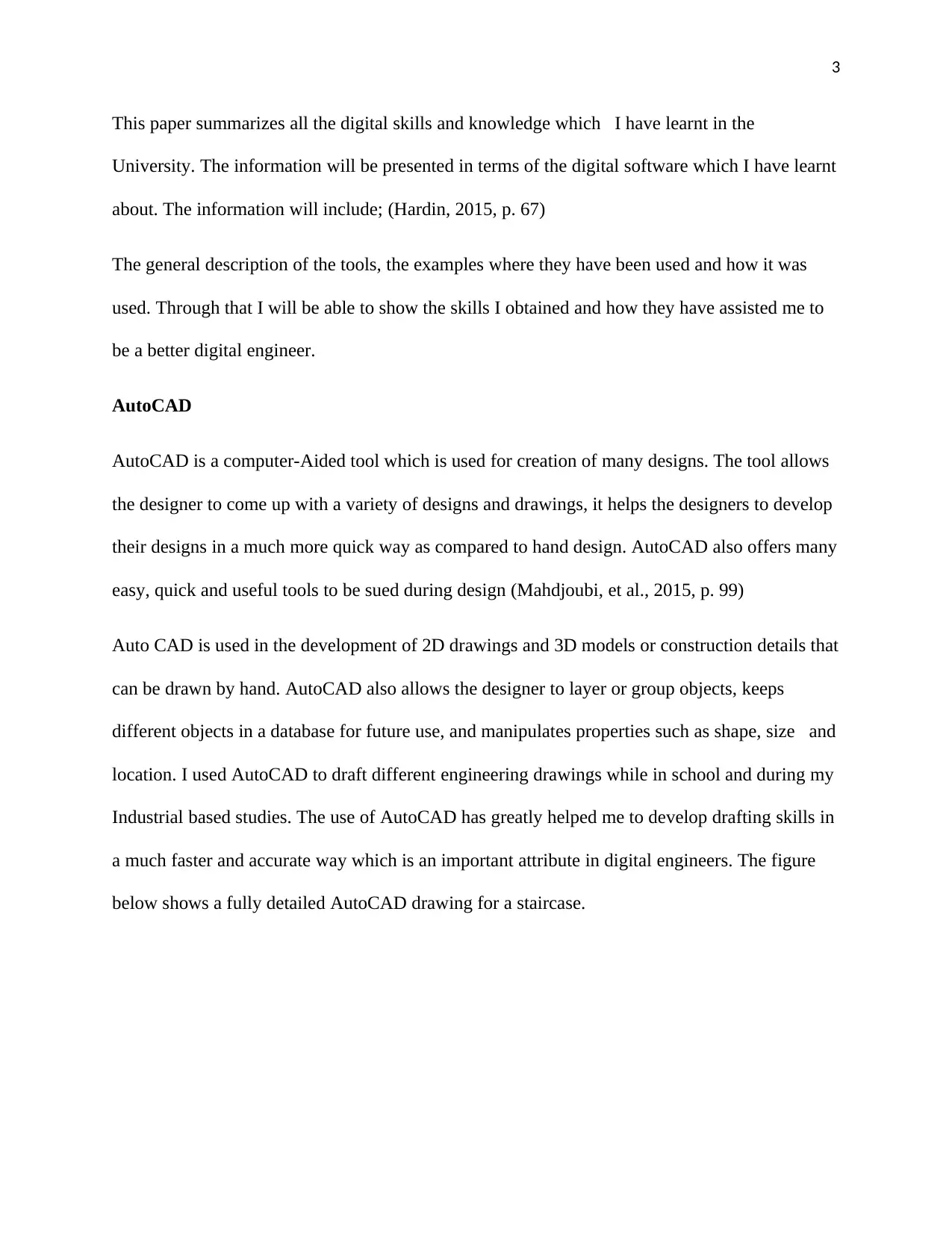
3
This paper summarizes all the digital skills and knowledge which I have learnt in the
University. The information will be presented in terms of the digital software which I have learnt
about. The information will include; (Hardin, 2015, p. 67)
The general description of the tools, the examples where they have been used and how it was
used. Through that I will be able to show the skills I obtained and how they have assisted me to
be a better digital engineer.
AutoCAD
AutoCAD is a computer-Aided tool which is used for creation of many designs. The tool allows
the designer to come up with a variety of designs and drawings, it helps the designers to develop
their designs in a much more quick way as compared to hand design. AutoCAD also offers many
easy, quick and useful tools to be sued during design (Mahdjoubi, et al., 2015, p. 99)
Auto CAD is used in the development of 2D drawings and 3D models or construction details that
can be drawn by hand. AutoCAD also allows the designer to layer or group objects, keeps
different objects in a database for future use, and manipulates properties such as shape, size and
location. I used AutoCAD to draft different engineering drawings while in school and during my
Industrial based studies. The use of AutoCAD has greatly helped me to develop drafting skills in
a much faster and accurate way which is an important attribute in digital engineers. The figure
below shows a fully detailed AutoCAD drawing for a staircase.
This paper summarizes all the digital skills and knowledge which I have learnt in the
University. The information will be presented in terms of the digital software which I have learnt
about. The information will include; (Hardin, 2015, p. 67)
The general description of the tools, the examples where they have been used and how it was
used. Through that I will be able to show the skills I obtained and how they have assisted me to
be a better digital engineer.
AutoCAD
AutoCAD is a computer-Aided tool which is used for creation of many designs. The tool allows
the designer to come up with a variety of designs and drawings, it helps the designers to develop
their designs in a much more quick way as compared to hand design. AutoCAD also offers many
easy, quick and useful tools to be sued during design (Mahdjoubi, et al., 2015, p. 99)
Auto CAD is used in the development of 2D drawings and 3D models or construction details that
can be drawn by hand. AutoCAD also allows the designer to layer or group objects, keeps
different objects in a database for future use, and manipulates properties such as shape, size and
location. I used AutoCAD to draft different engineering drawings while in school and during my
Industrial based studies. The use of AutoCAD has greatly helped me to develop drafting skills in
a much faster and accurate way which is an important attribute in digital engineers. The figure
below shows a fully detailed AutoCAD drawing for a staircase.
⊘ This is a preview!⊘
Do you want full access?
Subscribe today to unlock all pages.

Trusted by 1+ million students worldwide
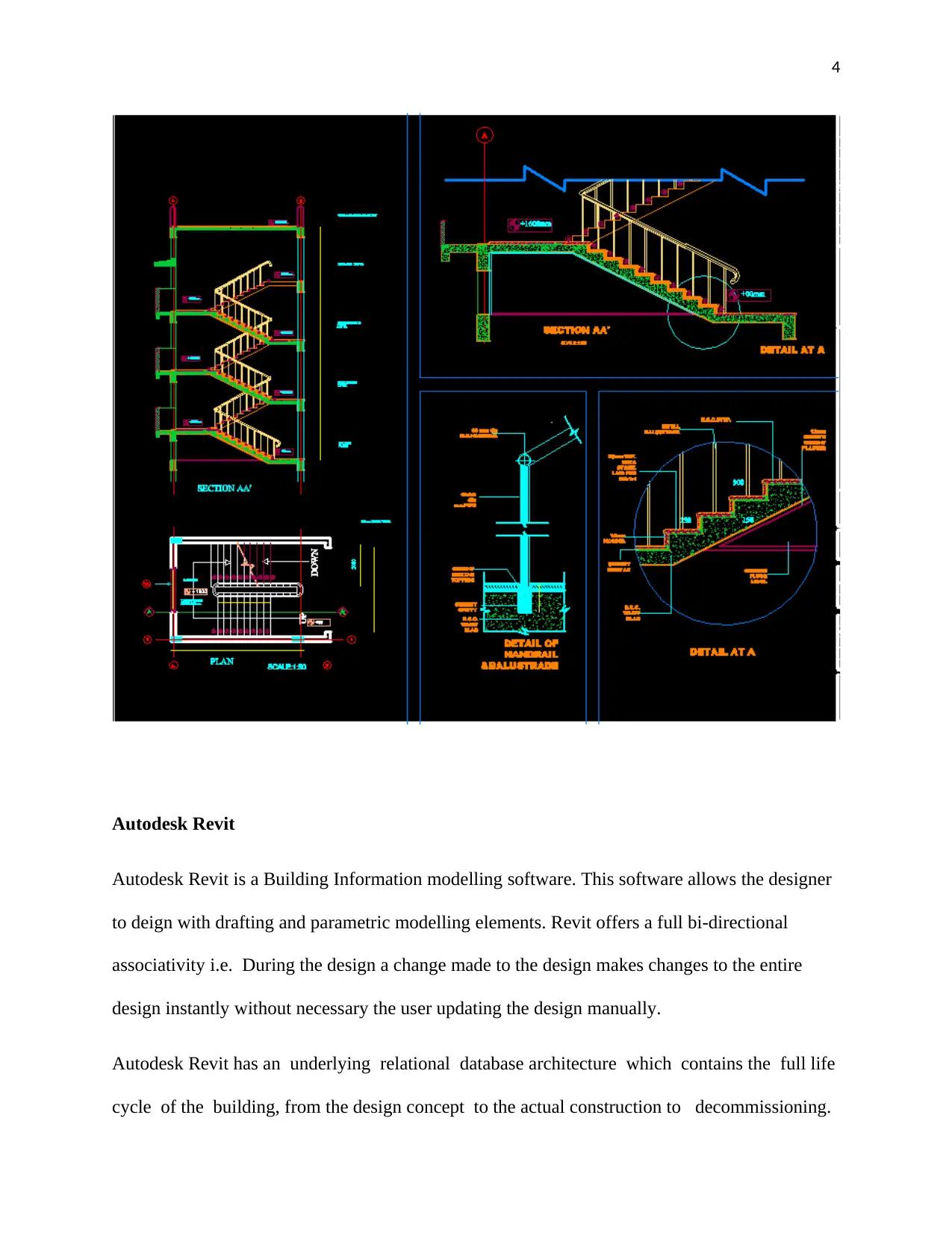
4
Autodesk Revit
Autodesk Revit is a Building Information modelling software. This software allows the designer
to deign with drafting and parametric modelling elements. Revit offers a full bi-directional
associativity i.e. During the design a change made to the design makes changes to the entire
design instantly without necessary the user updating the design manually.
Autodesk Revit has an underlying relational database architecture which contains the full life
cycle of the building, from the design concept to the actual construction to decommissioning.
Autodesk Revit
Autodesk Revit is a Building Information modelling software. This software allows the designer
to deign with drafting and parametric modelling elements. Revit offers a full bi-directional
associativity i.e. During the design a change made to the design makes changes to the entire
design instantly without necessary the user updating the design manually.
Autodesk Revit has an underlying relational database architecture which contains the full life
cycle of the building, from the design concept to the actual construction to decommissioning.
Paraphrase This Document
Need a fresh take? Get an instant paraphrase of this document with our AI Paraphraser

5
I used Autodesk during the designs of different structures such as housing design whereby the
building was drawn using different 3D objects to co9me up with floors, walls, structural
structure, windows, doors and other components of the building. Generally during the design,
any of the component which was to be seen in more than one view, it was created using 3D
objects. Also Autodesk Revit enables the designers to come up with their own 2D and 3D objects
for drafting and modelling purposes. (Underwood & Jason, 2014, p. 234)
The use of Autodesk Revit enables me to gain and develop the following skills and knowledge.
There is need when working together with other professionals from different disciplines on the
same project to make databases which can be linked to enable teamwork and easy consultation.
OASYS GSA
GSA is a software which is used to carry out structural analysis of different structures. The
software has ability to carry out buckling analysis, nonlinear analysis or dynamic analysis and
I used Autodesk during the designs of different structures such as housing design whereby the
building was drawn using different 3D objects to co9me up with floors, walls, structural
structure, windows, doors and other components of the building. Generally during the design,
any of the component which was to be seen in more than one view, it was created using 3D
objects. Also Autodesk Revit enables the designers to come up with their own 2D and 3D objects
for drafting and modelling purposes. (Underwood & Jason, 2014, p. 234)
The use of Autodesk Revit enables me to gain and develop the following skills and knowledge.
There is need when working together with other professionals from different disciplines on the
same project to make databases which can be linked to enable teamwork and easy consultation.
OASYS GSA
GSA is a software which is used to carry out structural analysis of different structures. The
software has ability to carry out buckling analysis, nonlinear analysis or dynamic analysis and
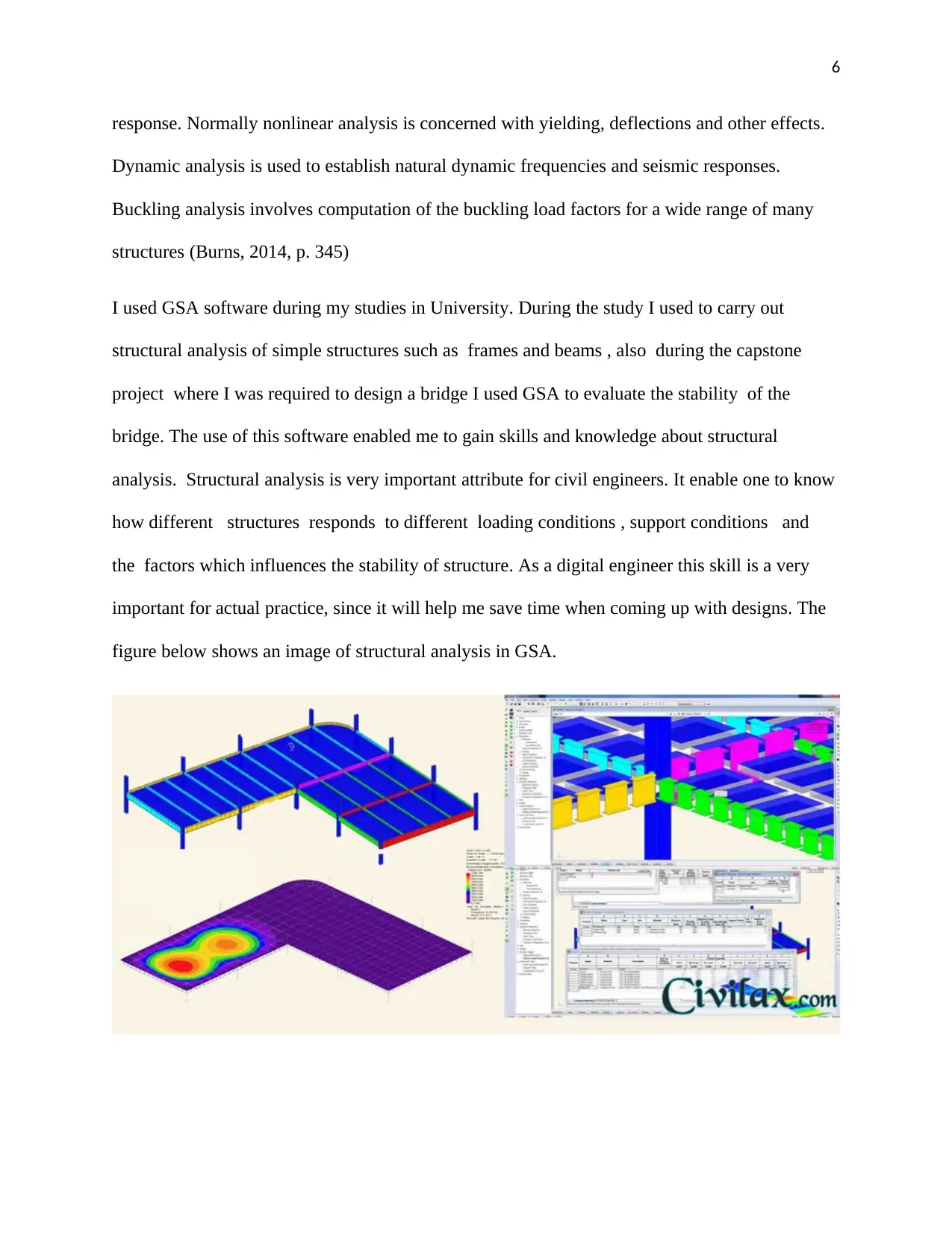
6
response. Normally nonlinear analysis is concerned with yielding, deflections and other effects.
Dynamic analysis is used to establish natural dynamic frequencies and seismic responses.
Buckling analysis involves computation of the buckling load factors for a wide range of many
structures (Burns, 2014, p. 345)
I used GSA software during my studies in University. During the study I used to carry out
structural analysis of simple structures such as frames and beams , also during the capstone
project where I was required to design a bridge I used GSA to evaluate the stability of the
bridge. The use of this software enabled me to gain skills and knowledge about structural
analysis. Structural analysis is very important attribute for civil engineers. It enable one to know
how different structures responds to different loading conditions , support conditions and
the factors which influences the stability of structure. As a digital engineer this skill is a very
important for actual practice, since it will help me save time when coming up with designs. The
figure below shows an image of structural analysis in GSA.
response. Normally nonlinear analysis is concerned with yielding, deflections and other effects.
Dynamic analysis is used to establish natural dynamic frequencies and seismic responses.
Buckling analysis involves computation of the buckling load factors for a wide range of many
structures (Burns, 2014, p. 345)
I used GSA software during my studies in University. During the study I used to carry out
structural analysis of simple structures such as frames and beams , also during the capstone
project where I was required to design a bridge I used GSA to evaluate the stability of the
bridge. The use of this software enabled me to gain skills and knowledge about structural
analysis. Structural analysis is very important attribute for civil engineers. It enable one to know
how different structures responds to different loading conditions , support conditions and
the factors which influences the stability of structure. As a digital engineer this skill is a very
important for actual practice, since it will help me save time when coming up with designs. The
figure below shows an image of structural analysis in GSA.
⊘ This is a preview!⊘
Do you want full access?
Subscribe today to unlock all pages.

Trusted by 1+ million students worldwide
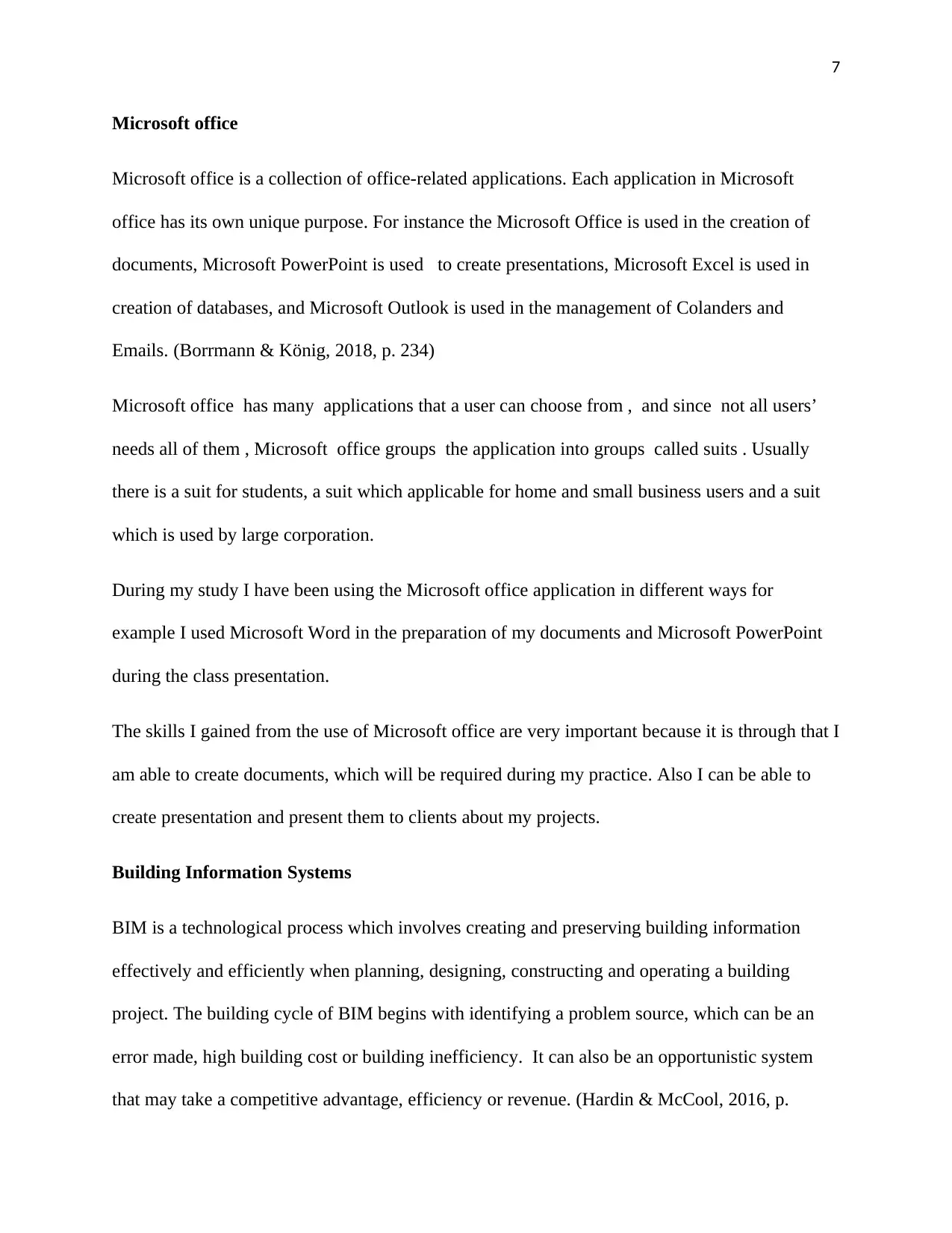
7
Microsoft office
Microsoft office is a collection of office-related applications. Each application in Microsoft
office has its own unique purpose. For instance the Microsoft Office is used in the creation of
documents, Microsoft PowerPoint is used to create presentations, Microsoft Excel is used in
creation of databases, and Microsoft Outlook is used in the management of Colanders and
Emails. (Borrmann & König, 2018, p. 234)
Microsoft office has many applications that a user can choose from , and since not all users’
needs all of them , Microsoft office groups the application into groups called suits . Usually
there is a suit for students, a suit which applicable for home and small business users and a suit
which is used by large corporation.
During my study I have been using the Microsoft office application in different ways for
example I used Microsoft Word in the preparation of my documents and Microsoft PowerPoint
during the class presentation.
The skills I gained from the use of Microsoft office are very important because it is through that I
am able to create documents, which will be required during my practice. Also I can be able to
create presentation and present them to clients about my projects.
Building Information Systems
BIM is a technological process which involves creating and preserving building information
effectively and efficiently when planning, designing, constructing and operating a building
project. The building cycle of BIM begins with identifying a problem source, which can be an
error made, high building cost or building inefficiency. It can also be an opportunistic system
that may take a competitive advantage, efficiency or revenue. (Hardin & McCool, 2016, p.
Microsoft office
Microsoft office is a collection of office-related applications. Each application in Microsoft
office has its own unique purpose. For instance the Microsoft Office is used in the creation of
documents, Microsoft PowerPoint is used to create presentations, Microsoft Excel is used in
creation of databases, and Microsoft Outlook is used in the management of Colanders and
Emails. (Borrmann & König, 2018, p. 234)
Microsoft office has many applications that a user can choose from , and since not all users’
needs all of them , Microsoft office groups the application into groups called suits . Usually
there is a suit for students, a suit which applicable for home and small business users and a suit
which is used by large corporation.
During my study I have been using the Microsoft office application in different ways for
example I used Microsoft Word in the preparation of my documents and Microsoft PowerPoint
during the class presentation.
The skills I gained from the use of Microsoft office are very important because it is through that I
am able to create documents, which will be required during my practice. Also I can be able to
create presentation and present them to clients about my projects.
Building Information Systems
BIM is a technological process which involves creating and preserving building information
effectively and efficiently when planning, designing, constructing and operating a building
project. The building cycle of BIM begins with identifying a problem source, which can be an
error made, high building cost or building inefficiency. It can also be an opportunistic system
that may take a competitive advantage, efficiency or revenue. (Hardin & McCool, 2016, p.
Paraphrase This Document
Need a fresh take? Get an instant paraphrase of this document with our AI Paraphraser
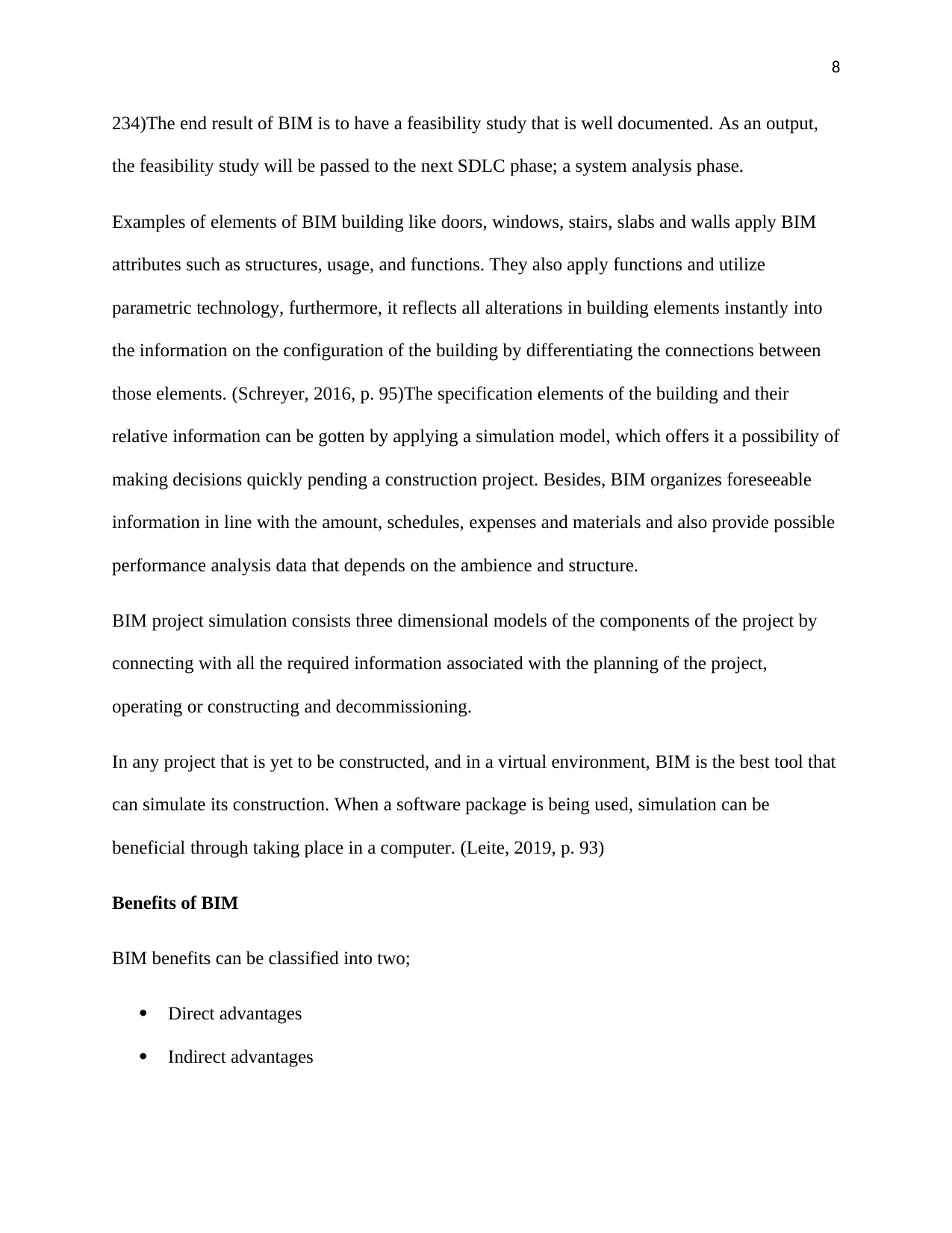
8
234)The end result of BIM is to have a feasibility study that is well documented. As an output,
the feasibility study will be passed to the next SDLC phase; a system analysis phase.
Examples of elements of BIM building like doors, windows, stairs, slabs and walls apply BIM
attributes such as structures, usage, and functions. They also apply functions and utilize
parametric technology, furthermore, it reflects all alterations in building elements instantly into
the information on the configuration of the building by differentiating the connections between
those elements. (Schreyer, 2016, p. 95)The specification elements of the building and their
relative information can be gotten by applying a simulation model, which offers it a possibility of
making decisions quickly pending a construction project. Besides, BIM organizes foreseeable
information in line with the amount, schedules, expenses and materials and also provide possible
performance analysis data that depends on the ambience and structure.
BIM project simulation consists three dimensional models of the components of the project by
connecting with all the required information associated with the planning of the project,
operating or constructing and decommissioning.
In any project that is yet to be constructed, and in a virtual environment, BIM is the best tool that
can simulate its construction. When a software package is being used, simulation can be
beneficial through taking place in a computer. (Leite, 2019, p. 93)
Benefits of BIM
BIM benefits can be classified into two;
Direct advantages
Indirect advantages
234)The end result of BIM is to have a feasibility study that is well documented. As an output,
the feasibility study will be passed to the next SDLC phase; a system analysis phase.
Examples of elements of BIM building like doors, windows, stairs, slabs and walls apply BIM
attributes such as structures, usage, and functions. They also apply functions and utilize
parametric technology, furthermore, it reflects all alterations in building elements instantly into
the information on the configuration of the building by differentiating the connections between
those elements. (Schreyer, 2016, p. 95)The specification elements of the building and their
relative information can be gotten by applying a simulation model, which offers it a possibility of
making decisions quickly pending a construction project. Besides, BIM organizes foreseeable
information in line with the amount, schedules, expenses and materials and also provide possible
performance analysis data that depends on the ambience and structure.
BIM project simulation consists three dimensional models of the components of the project by
connecting with all the required information associated with the planning of the project,
operating or constructing and decommissioning.
In any project that is yet to be constructed, and in a virtual environment, BIM is the best tool that
can simulate its construction. When a software package is being used, simulation can be
beneficial through taking place in a computer. (Leite, 2019, p. 93)
Benefits of BIM
BIM benefits can be classified into two;
Direct advantages
Indirect advantages

9
One of the direct advantages of BIM is quality. For instance, the improved imagination,
conception and building concentration information in the project.
Contrary, indirect benefits are important in providing the best project results of
understanding and reducing the risks of the project. Indirect benefits also enhances
cooperation. Simulations authorizes that a design’s plan be virtually checked before
construction of the real project. A model helps in creating the project’s visualization, which
offers the view of simulation concerning the needs of the project. This helps in describing the
project effectively. (A. Galiano-Garrigos, 2017, p. 445)
Therefore, the main benefits of BIM which have been structured are visualization,
elimination and collaboration.
Visualization specifies the benefits of in improving the BIM and personal improvement in
case an individual gets awareness on the importance of BIM utilization. Collaboration is the
cooperative behavior of some team members as it is being encouraged and facilitated by the
BIM. Elimination is the general benefits related to the project, like decreasing risks, wastes
and conflicts. (Nawari & Kuenstle, 2014, p. 87)
Planning and pre-construction
Presently, it is not usual to identify BIM applications in the project phase under pre-
construction. This is a big part due to the fact that it has easier models and little information
that is linked with the stage of planning it will be able to offer many advantages to the
project. This stage has been classified into two areas; firstly, to address conceptual features
of the design and marketing of the project. Secondly, planning and designing when
One of the direct advantages of BIM is quality. For instance, the improved imagination,
conception and building concentration information in the project.
Contrary, indirect benefits are important in providing the best project results of
understanding and reducing the risks of the project. Indirect benefits also enhances
cooperation. Simulations authorizes that a design’s plan be virtually checked before
construction of the real project. A model helps in creating the project’s visualization, which
offers the view of simulation concerning the needs of the project. This helps in describing the
project effectively. (A. Galiano-Garrigos, 2017, p. 445)
Therefore, the main benefits of BIM which have been structured are visualization,
elimination and collaboration.
Visualization specifies the benefits of in improving the BIM and personal improvement in
case an individual gets awareness on the importance of BIM utilization. Collaboration is the
cooperative behavior of some team members as it is being encouraged and facilitated by the
BIM. Elimination is the general benefits related to the project, like decreasing risks, wastes
and conflicts. (Nawari & Kuenstle, 2014, p. 87)
Planning and pre-construction
Presently, it is not usual to identify BIM applications in the project phase under pre-
construction. This is a big part due to the fact that it has easier models and little information
that is linked with the stage of planning it will be able to offer many advantages to the
project. This stage has been classified into two areas; firstly, to address conceptual features
of the design and marketing of the project. Secondly, planning and designing when
⊘ This is a preview!⊘
Do you want full access?
Subscribe today to unlock all pages.

Trusted by 1+ million students worldwide
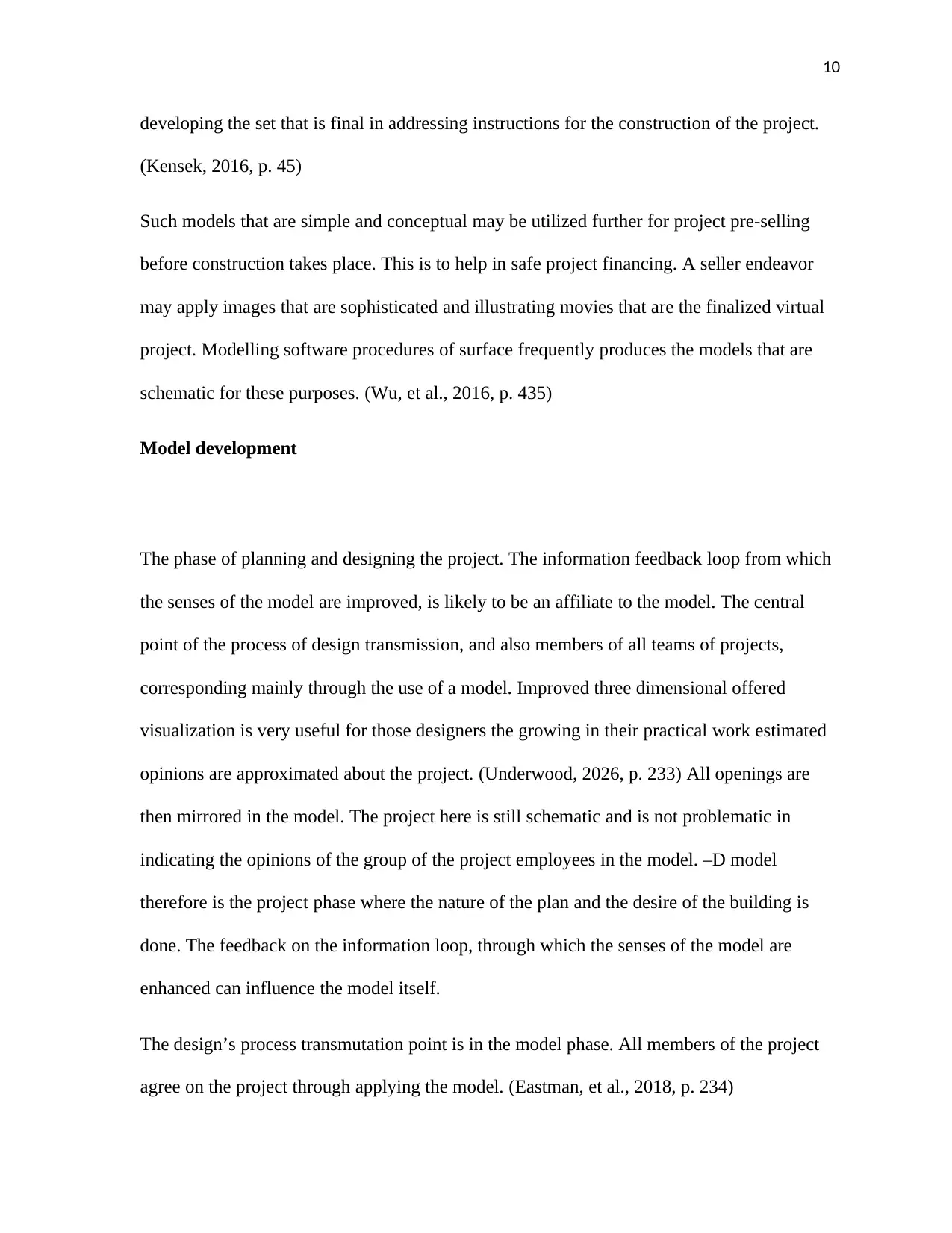
10
developing the set that is final in addressing instructions for the construction of the project.
(Kensek, 2016, p. 45)
Such models that are simple and conceptual may be utilized further for project pre-selling
before construction takes place. This is to help in safe project financing. A seller endeavor
may apply images that are sophisticated and illustrating movies that are the finalized virtual
project. Modelling software procedures of surface frequently produces the models that are
schematic for these purposes. (Wu, et al., 2016, p. 435)
Model development
The phase of planning and designing the project. The information feedback loop from which
the senses of the model are improved, is likely to be an affiliate to the model. The central
point of the process of design transmission, and also members of all teams of projects,
corresponding mainly through the use of a model. Improved three dimensional offered
visualization is very useful for those designers the growing in their practical work estimated
opinions are approximated about the project. (Underwood, 2026, p. 233) All openings are
then mirrored in the model. The project here is still schematic and is not problematic in
indicating the opinions of the group of the project employees in the model. –D model
therefore is the project phase where the nature of the plan and the desire of the building is
done. The feedback on the information loop, through which the senses of the model are
enhanced can influence the model itself.
The design’s process transmutation point is in the model phase. All members of the project
agree on the project through applying the model. (Eastman, et al., 2018, p. 234)
developing the set that is final in addressing instructions for the construction of the project.
(Kensek, 2016, p. 45)
Such models that are simple and conceptual may be utilized further for project pre-selling
before construction takes place. This is to help in safe project financing. A seller endeavor
may apply images that are sophisticated and illustrating movies that are the finalized virtual
project. Modelling software procedures of surface frequently produces the models that are
schematic for these purposes. (Wu, et al., 2016, p. 435)
Model development
The phase of planning and designing the project. The information feedback loop from which
the senses of the model are improved, is likely to be an affiliate to the model. The central
point of the process of design transmission, and also members of all teams of projects,
corresponding mainly through the use of a model. Improved three dimensional offered
visualization is very useful for those designers the growing in their practical work estimated
opinions are approximated about the project. (Underwood, 2026, p. 233) All openings are
then mirrored in the model. The project here is still schematic and is not problematic in
indicating the opinions of the group of the project employees in the model. –D model
therefore is the project phase where the nature of the plan and the desire of the building is
done. The feedback on the information loop, through which the senses of the model are
enhanced can influence the model itself.
The design’s process transmutation point is in the model phase. All members of the project
agree on the project through applying the model. (Eastman, et al., 2018, p. 234)
Paraphrase This Document
Need a fresh take? Get an instant paraphrase of this document with our AI Paraphraser
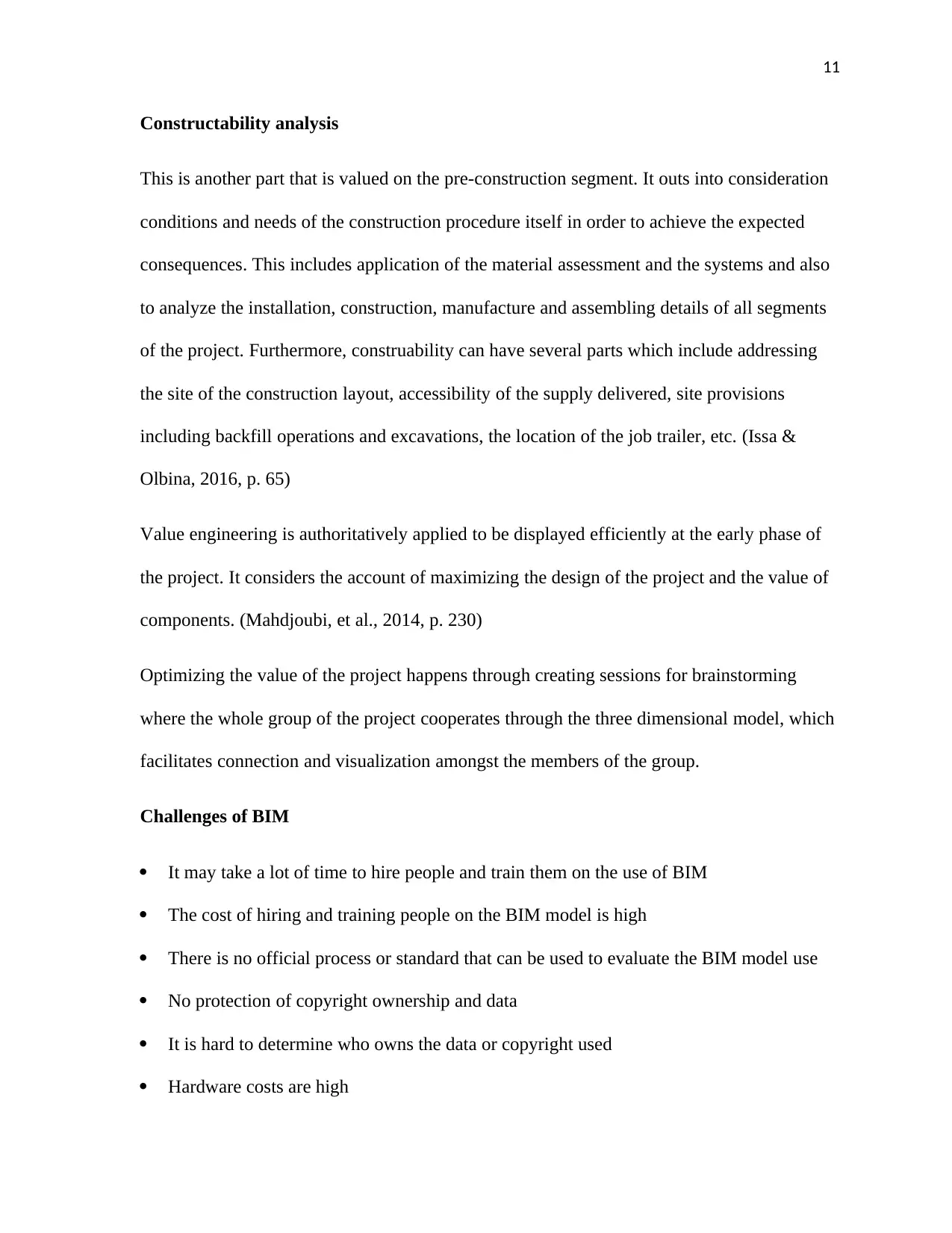
11
Constructability analysis
This is another part that is valued on the pre-construction segment. It outs into consideration
conditions and needs of the construction procedure itself in order to achieve the expected
consequences. This includes application of the material assessment and the systems and also
to analyze the installation, construction, manufacture and assembling details of all segments
of the project. Furthermore, construability can have several parts which include addressing
the site of the construction layout, accessibility of the supply delivered, site provisions
including backfill operations and excavations, the location of the job trailer, etc. (Issa &
Olbina, 2016, p. 65)
Value engineering is authoritatively applied to be displayed efficiently at the early phase of
the project. It considers the account of maximizing the design of the project and the value of
components. (Mahdjoubi, et al., 2014, p. 230)
Optimizing the value of the project happens through creating sessions for brainstorming
where the whole group of the project cooperates through the three dimensional model, which
facilitates connection and visualization amongst the members of the group.
Challenges of BIM
It may take a lot of time to hire people and train them on the use of BIM
The cost of hiring and training people on the BIM model is high
There is no official process or standard that can be used to evaluate the BIM model use
No protection of copyright ownership and data
It is hard to determine who owns the data or copyright used
Hardware costs are high
Constructability analysis
This is another part that is valued on the pre-construction segment. It outs into consideration
conditions and needs of the construction procedure itself in order to achieve the expected
consequences. This includes application of the material assessment and the systems and also
to analyze the installation, construction, manufacture and assembling details of all segments
of the project. Furthermore, construability can have several parts which include addressing
the site of the construction layout, accessibility of the supply delivered, site provisions
including backfill operations and excavations, the location of the job trailer, etc. (Issa &
Olbina, 2016, p. 65)
Value engineering is authoritatively applied to be displayed efficiently at the early phase of
the project. It considers the account of maximizing the design of the project and the value of
components. (Mahdjoubi, et al., 2014, p. 230)
Optimizing the value of the project happens through creating sessions for brainstorming
where the whole group of the project cooperates through the three dimensional model, which
facilitates connection and visualization amongst the members of the group.
Challenges of BIM
It may take a lot of time to hire people and train them on the use of BIM
The cost of hiring and training people on the BIM model is high
There is no official process or standard that can be used to evaluate the BIM model use
No protection of copyright ownership and data
It is hard to determine who owns the data or copyright used
Hardware costs are high
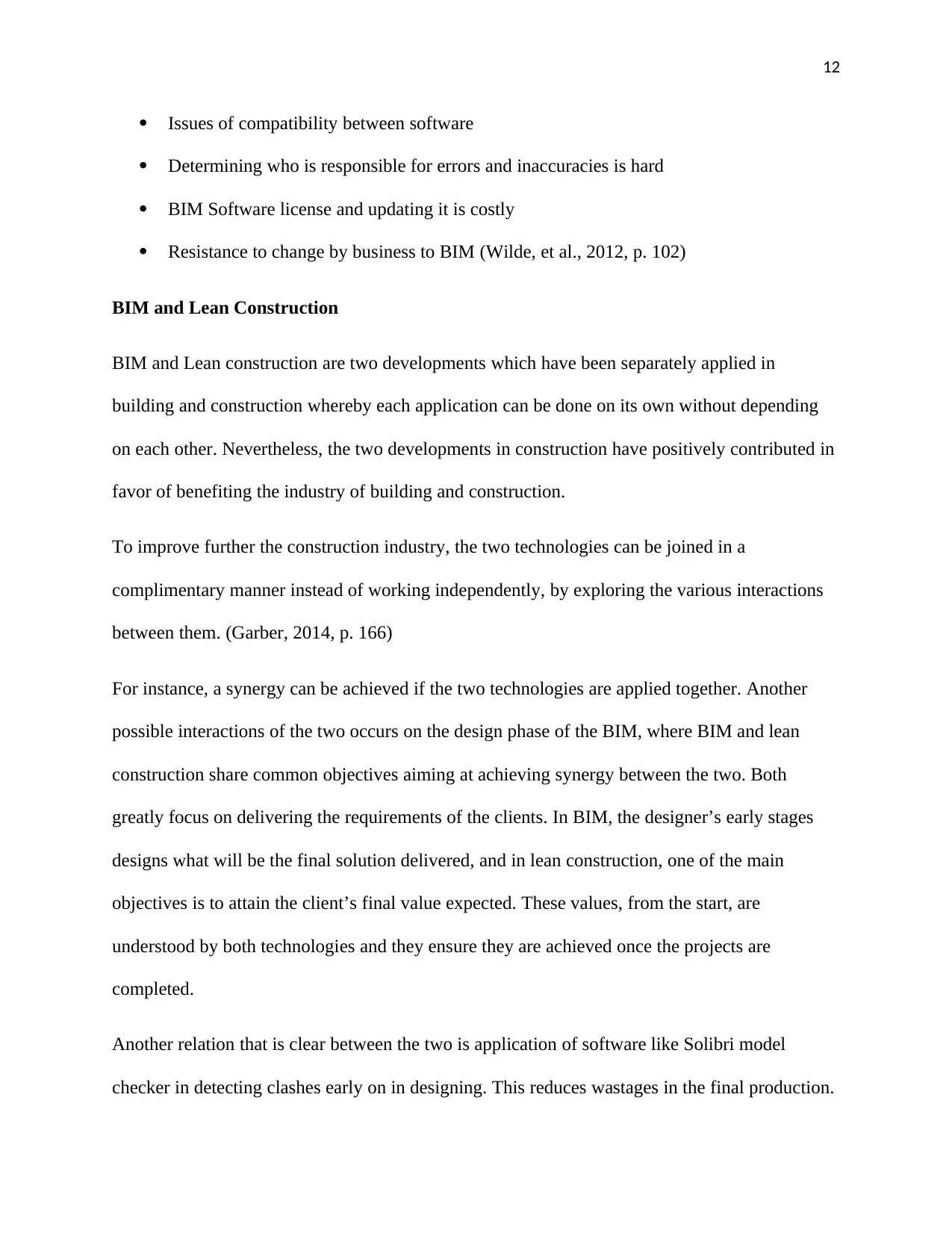
12
Issues of compatibility between software
Determining who is responsible for errors and inaccuracies is hard
BIM Software license and updating it is costly
Resistance to change by business to BIM (Wilde, et al., 2012, p. 102)
BIM and Lean Construction
BIM and Lean construction are two developments which have been separately applied in
building and construction whereby each application can be done on its own without depending
on each other. Nevertheless, the two developments in construction have positively contributed in
favor of benefiting the industry of building and construction.
To improve further the construction industry, the two technologies can be joined in a
complimentary manner instead of working independently, by exploring the various interactions
between them. (Garber, 2014, p. 166)
For instance, a synergy can be achieved if the two technologies are applied together. Another
possible interactions of the two occurs on the design phase of the BIM, where BIM and lean
construction share common objectives aiming at achieving synergy between the two. Both
greatly focus on delivering the requirements of the clients. In BIM, the designer’s early stages
designs what will be the final solution delivered, and in lean construction, one of the main
objectives is to attain the client’s final value expected. These values, from the start, are
understood by both technologies and they ensure they are achieved once the projects are
completed.
Another relation that is clear between the two is application of software like Solibri model
checker in detecting clashes early on in designing. This reduces wastages in the final production.
Issues of compatibility between software
Determining who is responsible for errors and inaccuracies is hard
BIM Software license and updating it is costly
Resistance to change by business to BIM (Wilde, et al., 2012, p. 102)
BIM and Lean Construction
BIM and Lean construction are two developments which have been separately applied in
building and construction whereby each application can be done on its own without depending
on each other. Nevertheless, the two developments in construction have positively contributed in
favor of benefiting the industry of building and construction.
To improve further the construction industry, the two technologies can be joined in a
complimentary manner instead of working independently, by exploring the various interactions
between them. (Garber, 2014, p. 166)
For instance, a synergy can be achieved if the two technologies are applied together. Another
possible interactions of the two occurs on the design phase of the BIM, where BIM and lean
construction share common objectives aiming at achieving synergy between the two. Both
greatly focus on delivering the requirements of the clients. In BIM, the designer’s early stages
designs what will be the final solution delivered, and in lean construction, one of the main
objectives is to attain the client’s final value expected. These values, from the start, are
understood by both technologies and they ensure they are achieved once the projects are
completed.
Another relation that is clear between the two is application of software like Solibri model
checker in detecting clashes early on in designing. This reduces wastages in the final production.
⊘ This is a preview!⊘
Do you want full access?
Subscribe today to unlock all pages.

Trusted by 1+ million students worldwide
1 out of 16
Related Documents
Your All-in-One AI-Powered Toolkit for Academic Success.
+13062052269
info@desklib.com
Available 24*7 on WhatsApp / Email
![[object Object]](/_next/static/media/star-bottom.7253800d.svg)
Unlock your academic potential
Copyright © 2020–2025 A2Z Services. All Rights Reserved. Developed and managed by ZUCOL.





